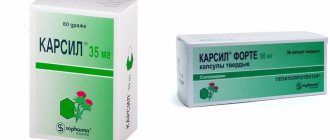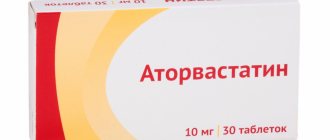Compound
flupenthixol as an active ingredient .
Auxiliary ingredients: lactose monohydrate, potato starch, gelatin, magnesium stearate, talc.
Shell: sucrose, gelatin, E172.
One milliliter of injection solution contains 20 mg or 100 mg of cis(Z)-flupenthixol decanoate , the active substance.
Additional components: medium chain triglycerides.
Pharmacodynamics and pharmacokinetics
A thioxanthene derivative , flupenthixol is an antipsychotic (psychotropic drug) with a pronounced activating, anxiolytic and antipsychotic effect.
The antipsychotic effects of the drug are associated with blocking dopamine receptors of 5-HT serotonin receptors is also suggested . Fluanxol has been proven to reduce the main symptoms of psychosis , including thinking disorders , paranoid delusions , and hallucinations .
The antipsychotic effectiveness of Fluanxol is observed when taking tablets orally at a daily dose of 3 mg. An increase in effect is observed with increasing both oral and intramuscular dosages of the drug.
Flupenthixol exhibits a disinhibitory (activating and anti-autistic) effect, and also reduces secondary signs of general mood disorder, which, in turn, helps stimulate patients with depressive symptoms, improves their communication skills and promotes rapid social adaptation .
In medium and small dosages (orally up to 25 mg per day and intramuscularly up to 100 mg once every 14 days), the drug does not have sedative effects . Nonspecific sedative effects may occur when high doses are used. When taken orally in small daily doses (up to 3 mg), antidepressant effectiveness of the drug is observed.
The intramuscular oil solution of flupenthixol is intended for depot injections and is a deposited form of the drug (Fluanxol Depot). The injection solution has a significantly longer duration of action compared to tablets, which is especially important when carrying out continuous antipsychotic treatment of patients who do not comply with all medical prescriptions.
The use of ampoule Fluanxol prevents frequent relapses observed when patients taking the drug orally interrupt therapy on their own. The intramuscular solution can be administered, depending on the pathology, at a frequency of once every 2-4 weeks.
Cmax in the blood is observed 3-6 hours after internal administration of the drug. Bioavailability at 40%.
The active ingredient of the ampoules is cis(Z)-flupenthixol decanoate , after intramuscular injection, amenable to enzymatic cleavage to release cis(Z)-flupenthixol and decanoic acid. In the blood, Cmax of cis(Z)-flupenthixol is observed approximately 7 days after administration.
The apparent Vd is 14.1 l/kg. The connection with plasma proteins is almost complete (99%). If the drug is used by intramuscular injection, Css is achieved after 3 months.
In small quantities, the active ingredient of the ampoules is present in mother's milk and also penetrates the placental barrier .
Metabolic products do not reveal neuroleptic activity.
When taken orally, T1/2 is approximately 35 hours. With intramuscular injections, the concentration of the drug decreases exponentially with T1/2 for about 3 weeks.
The drug is excreted to a greater extent in feces, and to a lesser extent in urine.
An IM dose of Fluanxol 40 mg, with a single administration every 14 days, is pharmacokinetically equivalent to a tableted daily dose of 10 mg, taken daily for 2 weeks.
Fluanxol 1 mg 50 pcs. film-coated tablets
pharmachologic effect
Antipsychotic drug (neuroleptic), thioxanthene derivative.
It has a pronounced antipsychotic effect, as well as activating, antidepressant and anxiolytic effects. The manifestation of the effects of flupenthixol depends on its dose. It is believed that the antipsychotic effect of neuroleptics is due to the blockade of dopamine receptors in the central nervous system. Thioxanthene derivatives have a high affinity for dopamine D1 and D2 receptors.
Unlike flupenthixol hydrochloride, flupenthixol decanoate is a depot form, its effect lasts for 2-4 weeks.
Composition and release form Fluanxol 1 mg 50 pcs. film-coated tablets
Tablets - 1 tablet:
- Active substance: flupenthixol dihydrochloride 1.168 mg, which corresponds to the content of flupenthixol 1 mg.
- Excipients: lactose monohydrate - 37 mg, potato starch - 73.5 mg, gelatin - 2.76 mg, talc - 8.4 mg, magnesium stearate - 0.6 mg.
- Shell composition: gelatin - 0.558 mg, sucrose - 50 mg, sucrose powder - 16.2 mg, iron oxide yellow (E172) - 0.25 mg, polishing wax Capol 1295® (a mixture of white beeswax and carnauba wax) - qs
50 pcs. - plastic containers (1) - cardboard packs.
Description of the dosage form
Tablets, coated (sugar), brownish-yellow, round, biconvex.
Directions for use and doses
The dose, frequency and duration of use are set individually depending on the indications, the dosage form used and the treatment regimen.
When taken orally, the daily dose varies from 1 mg to 40 mg in 1-3 doses.
With intramuscular administration, a single dose varies from 20 mg to 200 mg with an interval of 2-4 weeks.
Pharmacokinetics
After oral administration, Cmax of flupenthixol in plasma is achieved within 3-6 hours. Bioavailability is about 40%.
Flupenthixol and cis-(Z)-flupenthixol decanoate slightly penetrate the placental barrier and are excreted in small quantities in breast milk. Metabolites do not have neuroleptic activity.
After intramuscular administration of flupenthixol, decanoate undergoes enzymatic cleavage into the active component cis-(Z)-flupenthixol and decanoic acid. Cmax of cis-(Z)-flupenthixol in serum is achieved by the end of the first week after injection.
When taken orally, biological T1/2 is approximately 35 hours.
Flupentixol is excreted in the form of metabolites, mainly through the intestines and partly by the kidneys.
Indications for use Fluanxol 1 mg 50 pcs. film-coated tablets
For use in doses up to 3 mg/day: mild to moderate depression with anxiety, asthenia and lack of initiative; chronic neurotic disorders with anxiety, depression and apathy; psychosomatic disorders with asthenic reactions; acute and situationally determined anxiety, stressful conditions in which sedative/hypnotic effects are not required (especially if there is a suspicion that the patient is predisposed to abuse tranquilizers).
For use in doses of 3-40 mg/day: psychotic states with a predominance of hallucinations, paranoid delusions and thinking disorders, also accompanied by apathy, anergy and autism.
For use in doses of 40-150 mg/day: acute and chronic psychoses (including schizophrenia), resistant to therapy; alcohol withdrawal syndrome.
Contraindications
Acute alcohol intoxication, acute intoxication with barbiturates, opioid analgesics, coma, NMS, history of central hyperthermia, impaired liver function, impaired renal function, history of toxic agranulocytosis, parkinsonism, acute febrile states, hypersensitivity to antipsychotics of the thioxanthene structure.
Application of Fluanxol 1 mg 50 pcs. film-coated tablets during pregnancy and breastfeeding
Flupentixol and its active metabolite penetrate the placental barrier in small quantities and are excreted in breast milk in small concentrations. Use during pregnancy and lactation (breastfeeding) is not recommended.
special instructions
Flupenthixol should not be used in insufficiently high doses in patients in a state of agitation or hyperactivity.
Use with caution in patients with convulsive syndrome, chronic hepatitis, and cardiovascular diseases.
If NMS develops, you should immediately stop using flupenthixol and begin emergency symptomatic therapy.
In case of previous therapy with antipsychotics with sedative effects, their use should be discontinued gradually.
With long-term use of flupenthixol in high doses, it is necessary to regularly examine the patient's condition in order to switch to treatment using lower doses.
During treatment with flupenthixol, antiparkinsonian drugs should be prescribed only if there are appropriate indications and should not be used prophylactically.
Flupenthixol should not be used simultaneously with guanethidine and other drugs with a similar mechanism of action.
Impact on the ability to drive vehicles and operate machinery
Although in most cases the drug does not cause a sedative effect, it is necessary to take into account the possibility of its influence on the ability to drive a car and other mechanisms.
When using flupenthixol (especially at the beginning of treatment), potentially hazardous activities should be avoided until the individual response is determined.
Side effects Fluanxol 1 mg 50 pcs. film-coated tablets
From the side of the central nervous system: transient insomnia is possible (especially after previous treatment with antipsychotics with a sedative effect), sedation (when used in high doses), extrapyramidal disorders (mainly at the beginning of treatment); rarely, with long-term therapy - tardive dyskinesia.
From the digestive system: transient changes in liver function tests are possible.
Drug interactions
With simultaneous use, flupenthixol enhances the effects of drugs that have a depressant effect on the central nervous system, as well as ethanol; may potentiate the effect of anesthetics.
With simultaneous use, it is possible to reduce and completely suppress the hypotensive effect of guanethidine and drugs with a similar mechanism of action.
With simultaneous use, it is possible to reduce the effects of levodopa and adrenergic drugs.
When used simultaneously with lithium carbonate, the development of extrapyramidal disorders is possible; with metoclopramide, piperazine - the risk of developing extrapyramidal disorders increases.
Indications for use
When taken orally at a daily dose of up to 3 mg:
- depressive states of moderate and mild severity, accompanied by anxiety , lack of initiative and asthenia ;
- neurotic disorders of a chronic nature, with apathy , depression and anxiety ;
- psychosomatic disorders with asthenic conditions.
When taken orally, a daily dose of 3 mg or more:
- schizophrenia-like psychoses and schizophrenia with a dominance of hallucinatory symptoms, thinking disorders , delusions , which are accompanied by autism , anergy , apathy and low mood.
When used as an intramuscular injection:
- schizophrenia and other psychotic disorders with autism , anergy , apathy and low mood, accompanied by hallucinations , thinking disorders, delusions .
Contraindications
- any conditions accompanied by suppression of consciousness , including due to the use of alcohol , opioid analgesics or barbiturates ;
- congenital intolerance to fructose and/or galactose;
- deficiency of isomaltase, lactase, sucrase;
- impaired absorption of galactose and glucose (for tablets);
- vascular collapse;
- coma;
- age under 18 years;
- hypersensitivity to the ingredients of the drug or phenothiazines .
Carefully:
- organic pathologies of the brain;
- convulsive conditions, epilepsy (possible increase in the frequency of seizures as a result of a decrease in convulsive readiness);
- increased risk of stroke ;
- liver failure ;
- hypomagnesemia , hypokalemia ;
- history of cardiovascular diseases (increased risk of low blood pressure ), including bradycardia (less than 50 beats/min), prolongation of the QT interval , recent myocardial infarction , arrhythmia , heart failure (uncompensated);
- glaucoma or risk factors for its development;
- gastrointestinal ulcer;
- alcoholism (possibly increased CNS depression);
- leukopenia;
- pheochromocytoma;
- breathing disorders that are associated with acute infections, emphysema , bronchial asthma ;
- Parkinson's disease (exacerbation of extrapyramidal effects);
- Reye's syndrome (possible increase in hepatotoxicity);
- urinary retention and prostate adenoma with clinical manifestations;
- periods of breastfeeding and pregnancy .
Patients with psychomotor agitation are not recommended to use Fluanxol in a daily dose of up to 25 mg, due to the activating effect of small doses of the drug (up to 3 mg per day for oral administration and 10-20 mg once every 14 days for intramuscular injections), which may cause exacerbation of existing symptoms.
Manifestations of withdrawal syndrome
Stopping taking the antipsychotic fluanxol may trigger a withdrawal reaction. This condition is in some ways similar to withdrawal syndrome, but is not so severe and can be treated with medication.
It appears a few days after stopping treatment, and the duration is directly related to the previous course of use of the drug: the longer a person took the medicine, the longer the adaptation phase. Typically this period lasts from seven days to a month.
At this time, the body gets used to living without antipsychotics and experiences stress, during which the following side effects of fluanxol withdrawal are possible:
- nausea, vomiting, diarrhea and other digestive tract disorders;
- sleep disturbance, anxiety and nervousness;
- increased sweating;
- hand tremors, muscle spasms;
- headaches and sudden changes in blood pressure;
- heart failure;
- disorders of consciousness.
Throughout the entire period until the patient’s state of health stabilizes, the patient needs the help of a specialist who can, if necessary, prescribe a course of maintenance drug therapy.
Side effects
Nervous system (NS):
- headache;
- drowsiness;
- tremor;
- parkinsonism;
- akathisia;
- hypokinesia;
- speech disorders;
- dystonia;
- depression;
- nervousness;
- insomnia;
- agitation;
- dizziness;
- extrapyramidal disorders (hyperkinesis, muscle rigidity);
- attention disorders;
- dyskinesia;
- seizure disorders;
- amnesia;
- aggression;
- confusion;
- decreased libido;
- tardive dystonia.
It must be remembered that when taking antipsychotics , the group of which includes flupentixol , the development of NMS ( neuroleptic malignant syndrome ) was sometimes observed.
The main symptoms of NMS are manifested by hyperthermia , impaired consciousness and muscle rigidity with parallel dysfunction of the autonomic nervous system ( tachycardia , labile blood pressure , increased sweating ). If these symptoms occur, the antipsychotic and symptomatic and supportive treatment should be prescribed.
Long-term therapy with Fluanxol can lead to the development of tardive dyskinesia . The use of antiparkinsonian drugs does not eliminate symptoms, but, on the contrary, can intensify them.
In this case, a dose reduction is indicated until treatment is discontinued.
In case of persistent akathisia , effective drugs are: Propranolol or benzodiazepines .
Feelings of anxiety or transient insomnia may occur especially when previously taking antipsychotics that have a sedative effect .
motility disorders may occur .
These disorders are leveled out by lowering doses and/or prescribing antiparkinsonian drugs, the constant use of which, in order to prevent side effects, is not recommended.
The cardiovascular system:
- tachycardia;
- orthostatic hypotension ;
- ventricular arrhythmia (ventricular tachycardia , ventricular fibrillation , tachycardia of the “pirouette” type, sudden death );
- prolongation of the QT interval.
Hematopoietic system:
- hemolytic anemia ;
- agranulocytosis (most often during the period between 4 and 10 weeks of therapy);
- granulocytopenia;
- leukopenia.
Organ of vision:
- clouding of the lens and/or cornea, with the possibility of visual impairment;
- disturbance of accommodation;
- accommodation paresis;
- oculogyric crisis.
Gastrointestinal system:
- digestive disorders ( diarrhea , nausea , dyspepsia , constipation );
- dry mouth;
- increased salivation ;
- vomit;
- dysphagia;
- cholestatic jaundice (most often during the period between 4 and 10 weeks of therapy);
- decreased appetite;
- transient minor changes in liver enzymes.
Endocrine system:
- gynecomastia;
- galactorrhea;
- dysmenorrhea;
- decreased libido;
- weight gain;
- impotence;
- increased appetite;
- carbohydrate metabolism disorders;
- tides.
Reproductive system:
- erectile disfunction.
Urinary system:
- painful urination;
- urinary retention.
Musculoskeletal system:
- arthralgia.
Allergic manifestations:
- increased sweating;
- dermatitis;
- skin rash and itching ;
- photosensitivity.
Local complications:
- swelling;
- erythema;
- abscess;
- inflammation.
Other:
- asthenia;
- weakness.
Fluanxol®
When taking any antipsychotics, there is a possibility of developing neuroleptic malignant syndrome (hyperthermia, muscle rigidity, episodes of loss of consciousness, instability of the autonomic nervous system).
The risk increases with stronger drugs.
Patients with existing organic brain diseases, mental retardation, and opioid and alcohol dependence have a higher incidence of death.
Treatment: Stop taking antipsychotics. Prescribe symptomatic and restorative therapy. The use of dantrolene and bromocriptine is recommended. Symptoms may persist for more than a week after stopping oral antipsychotics and longer when using depot forms.
Like other antipsychotics, flupentixol should be prescribed with caution to patients with organic brain diseases, seizure disorders and severe liver dysfunction.
It is not recommended to prescribe doses up to 25 mg/day to excitable or hyperactive patients, since the activating effect of the drug can lead to a worsening of the patient's condition. If the patient received tranquilizers or antipsychotics that have a sedative effect, they should be withdrawn gradually.
Like other psychotropic drugs, flupenthixol may change the concentration of insulin and glucose in the blood, which may require dose adjustment of hypoglycemic drugs in patients with diabetes.
During long-term therapy, especially at high doses, it is necessary to carry out careful monitoring, periodically assessing the condition of patients in order to decide on the possibility of reducing the maintenance dose.
Like other drugs belonging to the therapeutic class of antipsychotics, flupentixol may cause QT prolongation.
Persistently prolonged QT intervals may increase the risk of malignant arrhythmias. Therefore, flupentixol should be used with caution in patients with hypokalemia, hypomagnesemia and a genetic predisposition to such conditions and in patients with a history of cardiovascular disease, such as QT prolongation, significant bradycardia (<50 beats per minute), recent acute myocardial infarction, decompensated heart failure or arrhythmia. Concomitant use with other antipsychotics should be avoided (see section “Interaction with other drugs”).
Depression is associated with an increased risk of suicidal ideation, self-harm, and suicide (suicidal events). This risk persists until significant remission occurs. Since improvement may not be observed during the first few weeks of therapy or even longer, patients should be closely monitored until their condition improves.
General clinical practice shows that in the early stages of recovery the risk of suicide may increase.
Other psychiatric conditions for which flupenthixol is prescribed may also be associated with an increased risk of suicidal events. In addition, these conditions may be a comorbidity in relation to a depressive episode. When treating patients with other mental disorders, the same precautions should be taken as when treating patients with a depressive episode.
Patients with a history of suicidal behavior or patients with a significant level of suicidal thoughts before treatment are at greater risk for suicidal ideation or suicide attempts and should be closely monitored during treatment. A meta-analysis of placebo-controlled clinical trials of antidepressants in adult patients with mental disorders found that there is an increased risk of suicidal behavior in patients under 25 years of age when taking antidepressants compared with placebo. Drug treatment of these patients, and in particular those at high risk for suicide, should be accompanied by careful monitoring, especially early in treatment and during dose changes. Patients (and caregivers) should be warned to monitor for any signs of clinical worsening, suicidal behavior or ideation, or unusual changes in behavior, and to seek immediate medical advice if these symptoms occur.
Cases of venous thromboembolism have been reported while taking antipsychotics. Due to the fact that patients being treated with antipsychotics are often at risk for developing venous thromboembolism, risk factors for developing venous thromboembolism should be determined before and during treatment with flupenthixol and precautions should be taken.
Elderly patients
Cerebrovascular adverse reactions
In randomized, placebo-controlled clinical trials of certain atypical antipsychotics in patients with dementia, a 3-fold increase in the risk of cerebrovascular adverse reactions was observed. The mechanism for this increased risk is unknown. An increased risk cannot be ruled out when using other antipsychotics in
other groups of patients. Flupenthixol should be used with caution in patients at risk of stroke.
Increased mortality in older patients with dementia
Data from two large observational studies showed that older patients with dementia who took antipsychotic drugs had a small increased risk of death compared with patients not taking antipsychotic drugs. There is no sufficient data to accurately assess the magnitude of the risk and the reasons for its increase. Fluanxol is not registered for the treatment of behavioral disorders in patients with dementia.
Excipients
The tablets contain lactose monohydrate. Patients with rare hereditary galactose intolerance, lactase deficiency or impaired absorption of glucose and galactose should not take this drug. 5 mg tablets contain the dye Sunset Yellow Aluminum Lacquer (E110) (FD&C, FCF), which may cause allergic reactions.
Fluanxol tablets, instructions for use (Method and dosage)
Instructions for use of Fluanxol recommends taking it orally (orally) with water.
When taking tablets in a daily dose of up to 3 mg:
For the treatment of moderate and mild depressive states of anxiety , lack of initiative and asthenia ; chronic neurotic disorders apathy , depression and anxiety; For psychosomatic disorders with asthenia , Fluanxol is prescribed in an initial daily dose of 1 mg once in the morning, or in a half dose (500 mcg) twice a day.
In the absence of positive therapeutic dynamics over 7 days, you can increase the daily dose to 2 mg. The dosage of tablets is from 2 mg to 3 mg, must be taken in several doses. For elderly patients, a daily dose of 0.5 to 1.5 mg is recommended.
As a rule, the therapeutic effect of Fluanxol manifests itself within 2-3 days. If the maximum possible daily dosage of 3 mg tablets for a week is ineffective, therapy is discontinued.
When taking tablets in a daily dose of 3 mg or higher:
For the treatment of psychotic disorders, the dose of Fluanxol is selected individually, depending on the general condition of the patient.
At the beginning of therapy, it is recommended to take low doses of the drug, subsequently moving, depending on the individual response of the patient, to taking higher doses, until the optimal effective dosage is determined.
Therapy begins with a daily dose of 3 to 15 mg, depending on the severity of the condition. This dose must be divided into 2-3 doses. If necessary, this dosage can be increased to 20-30 mg.
The maximum permissible dose of tablets per day is 40 mg. Maintenance therapy is carried out in a daily dose of 5-20 mg.
When using IM injection solution:
The injection solution is indicated for intramuscular injection deep into the outer upper quadrant of one of the buttocks. Injecting the solution into other muscles is not advisable. If it is necessary to administer more than 2 ml of solution, it is recommended to make 2 injections.
The dosage of ampoules of 20 mg/ml is usually 1-2 ml (20-40 mg), administered once every 2-4 weeks. Some patients require higher doses of the drug or shorter intervals between doses.
In case of acute relapse or exacerbation of the disease, it may be necessary to administer high doses of the solution, up to 400 mg once, with a frequency of 14 or even 7 days.
When switching from the oral form of Fluanxol to intramuscular injection:
When switching from taking tablets to using intramuscular injections, it is necessary to calculate the daily dose of the solution.
To do this, the daily oral dose of tablets (mg) is multiplied by four, which will constitute a single dose of intramuscular solution (mg), administered once every 2 weeks.
In parallel, for 7 days after the 1st injection, it is necessary to continue taking the tablets, but in a smaller dose.
Subsequently, the dosage of injections and the intervals between them are established based on the individual clinical effect. The one-time maximum dose of the intramuscular solution is 400 mg with an interval of 7 days.
Patients switching to Fluanxol IM solution from other drugs in depot forms should use it in the following ratios: flupenthixol decanoate at a dose of 40 mg corresponds to 200 mg zuclopenthixol decanoate , 25 mg fluphenazine decanoate or 50 mg haloperidol decanoate .
Area and methods of application
Features of the chemical structure of a pharmacological agent directly affect its clinical properties. Substances of this class are used in the treatment of psychotic conditions that occur in patients of drug treatment clinics. These include mental disorders, paranoid manifestations, various psychoses, anxieties and phobias.
The effect of fluanxol on the human body is not limited to this list. In certain doses and in combination with other psychotropic medications, it is used to overcome obsessive-compulsive and personality disorders. This remedy has a sedative and neurotropic property, reduces psychomotor activity, and even has an antiemetic effect.
Tablet forms are taken in strict accordance with the doctor's prescription. If the substance is administered through intramuscular injections into the soft tissue of the buttock, then at certain doses the entire volume is divided into two injections and administered to different places.
Fluanxol is widely used in many areas of medicine, but most often in psychiatry and narcology. When prescribing this drug, the narcologist takes into account the physical and mental state of the patient to calculate the optimal dose. In addition, medical monitoring of the client’s well-being will be required in order to respond in a timely manner to negative manifestations from the antipsychotic.
Overdose
In case of an overdose of Fluanxol, the following may occur: drowsiness , hypo- or hyperthermia, shock , convulsions , extrapyramidal disorders , coma .
When used in combination with drugs that affect cardiac activity, the following are possible: changes in the ECG , ventricular arrhythmias , prolongation of the QT interval, cardiac arrest .
Supportive and symptomatic treatment is recommended. In case of oral administration of high doses of the drug, the stomach is washed and sorbents .
Measures should also be taken to maintain breathing and cardiovascular activity. Taking epinephrine ( Adrenaline ) is not recommended, as it can cause a decrease in blood pressure .
Seizures are relieved with Diazepam , and Biperiden .
Interaction
When using Fluanxol, it is possible to enhance the sedative effects of barbiturates , ethanol and other drugs that have a depressant effect on the central nervous system.
The drug should not be prescribed in parallel with Guanethidine and drugs with similar effects, since Fluanxol may weaken their antihypertensive effectiveness.
Flupenthixol together with tricyclic antidepressants inhibit each other's metabolism.
Combined use with lithium preparations may increase neurotoxicity .
Fluanxol may reduce the effect of Levodopa and adrenergic drugs .
The risk of extrapyramidal disorders increases when Fluanxol is used together with Piperazine and Metoclopramide .
Due to a possible increase in the QT interval, it is not recommended to prescribe flupentixol simultaneously with drugs that have a similar effect.
Among these drugs are: antiarrhythmic drugs of classes IA and III ( Dofetilide , Amiodarone , Quinidine , Sotalol ); antipsychotic drugs ( Thioridazine ); macrolides ( Erythromycin ); quinolones ( Moxifloxacin , Gatifloxacin ); antihistamines ( Astemizole , Terfenadine ); lithium preparations; cisapride .
When used in parallel with drugs that cause electrolyte imbalance ( thiazide-like and thiazide diuretics ), as well as drugs that increase the content of flupenthixol in the blood, an increase in the QT interval and the development of life-threatening arrhythmias
Fluanxol IM solution cannot be mixed with deposited forms based on sesame oil due to a significant effect on their joint pharmacokinetics.
Pathogenesis of complications development
Fluanxol, as a thioxanthene derivative, has a wide spectrum of action, directly affecting individual structures of the central nervous system. The complexity of using the drug leads to a specific form of addiction to it. The drug does not cause drug dependence, but during and after stopping its use, side effects and Fluanxol withdrawal syndrome may occur.
The mechanism of development of such reactions is determined by the peculiarities of the functioning of the central nervous system. The complications are based on changes in the sensitivity of the corresponding brain structures to the effects of chemical compounds. The absence of the usual inhibitory effect on synapses or an inadequate response of cells to the action of the drug leads to a deterioration in the patient’s well-being. This condition is accompanied by neurological, mental and other symptoms.
special instructions
The use of Fluanxol in parallel treatment of diabetes mellitus may require adjustment of insulin .
With previous therapy with tranquilizers and antipsychotics with sedative effects, their use should be stopped gradually.
Long-term therapy with Fluanxol, especially in high doses, requires careful monitoring and assessment of the patient's condition for timely adjustment of maintenance doses.
You should refrain from driving vehicles, as well as precise and dangerous work.
Content:
- Area and methods of application
- Fluanxol: side effects
- Manifestations of withdrawal syndrome
- Contraindications for antipsychotic treatment
The effectiveness of treatment with psychotropic drugs depends on the correct choice of pharmacological agent, taking into account the history of the disease and the patient’s well-being.
In narcology, as in any other field of medicine, when planning drug therapy, it is important to take into account the entire range of medications used. Since their interaction may change the expected result or cause accompanying reactions. The drug fluanxol, which belongs to the group of antipsychotics, is widely used in the treatment of alcohol dependence. Thanks to its antipsychotic and antidepressant effect, it helps patients overcome difficult periods of struggle with addiction.
During pregnancy and lactation
The use of Fluanxol during pregnancy and breastfeeding is possible only in cases where the expected benefit of treatment for the mother far outweighs the possible risk to the fetus.
Cases have been described of the use of antipsychotics during childbirth or in the third trimester of pregnancy , which led to signs of intoxication ( tremor , lethargy , excessive excitability ) in the newborn. In addition, they had a low Apgar score.
If there is a clinical need for the use of Fluanxol during lactation , you should monitor the health of the newborn, especially in the first month after birth, or stop breastfeeding.
Literature:
- A short reference book on psychopharmacology, pharmacotherapy and mental pathology / Kozlovsky, Vladimir Leonidovich. / St. Petersburg: SpetsLit, 2015.
- Modern psychotropic drugs used in psychiatry: educational and methodological manual / [Olga Fedorovna Pankova, Artem Vyacheslavovich Alekseev, Alexander Viktorovich Abramov]; Ministry of Health of the Russian Federation, Federal State Autonomous Educational Institution of Higher Education "Russian National Research Medical University named after N. I. Pirogov" (FGAU HE RNRMU named after N. I. Pirogov of the Ministry of Health of Russia), Department of Psychiatry and Medical Psychology. — Moscow: Federal State Autonomous Educational Institution of Russian National Research Medical University named after. N.I. Pirogova Ministry of Health of Russia, 2021. - 135 p.
- Features of pathological craving for alcohol in patients with excitable personality traits in premorbidity (clinic, therapy): dissertation ... candidate of medical sciences: 14.00.45 / Volkova Elena Valentinovna; [Place of protection: Federal State Institution "National Scientific Center for Narcology"]. - Moscow, 2008. - 164 p.
Fluanxol price, where to buy
In Russian pharmacies the average price of Fluanxol is:
- tablets 0.5 mg No. 50 – 330 rubles;
- tablets 1 mg No. 50 – 480 rubles;
- tablets 5 mg No. 100 – 1100 rubles;
- ampoules 20 mg/ml 1 ml No. 10 – 2000 rubles.
- Online pharmacies in RussiaRussia
- Online pharmacies in UkraineUkraine
ZdravCity
- Fluanxol solution in / m oil.
20 mg/ml 1 ml 10 pcs. Lundbeck 1010 rub. order - Fluanxol tab. p/o captivity. 1mg №50H.Lundbeck A/S
400 rub. order
- Fluanxol tablets p.p.o 5mg 100pcs H.Lundbeck A/S
RUR 1,021 order
Pharmacy Dialogue
- Fluanxol (tablet p/o 1 mg No. 50) Lundbeck
RUB 381 order
- Fluanxol (tablet p/o 5 mg No. 100) Lundbeck
RUR 1,028 order
show more
Pharmacy24
- Fluanxol 0.5 mg No. 100 tablets H. Lundbeck A/S, Denmark
300 UAH. order - Fluanxol depot 20 mg 1 ml No. 10 injection solution H. Lundbeck A/S, Denmark
858 UAH order
- Fluanxol 1 mg No. 100 tablets H. Lundbeck A/S, Denmark
261 UAH. order








